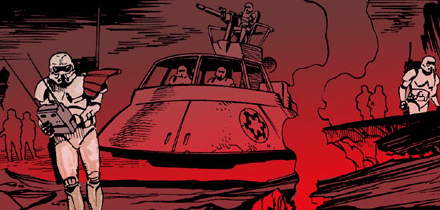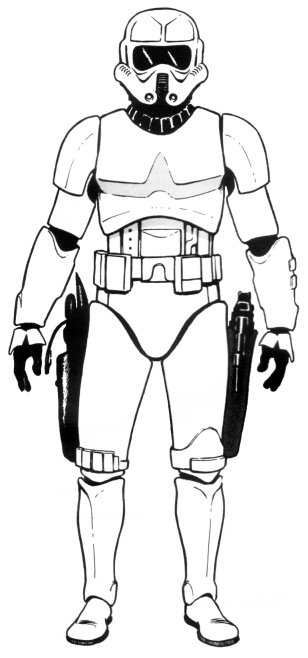The distinctive silver and black battle armor of the radiation zone assault troopers was a modification of the standard plastoid stormtrooper armor and provided protection against radiation as well as biological and chemical exposure. It was stress reinforced and contained a heat and radiation reflective coating.

Radtroopers deployed to Qat Chrystac.
A lead-polymer substrate that gave protection needed to withstand lethal Grade 5 radiation zone for several hours. The suit also consisted of a one-piece wrap-around backpack unit that contained a heat and radiation cooling unit with energy source and portable environment unit.
Their helmets were stress reinforced with automatic polarizing lenses, an integrated comlink and breathing filters. The view plate contained macrobinoculars with blast shield and UV sensors. Under the armor the trooper was enclosed in a black two-piece temperature controlled and radiation sealed body glove.
The armor was designed by Dr. Nashiak Llalik.
Radiation zones above Grade 4 caused continuous malfunctions in most powered weapons. As a result radtroopers blaster carbines were more powerful than standard stormtrooper issue weapons to compensate for the effects of malfunctions. Unlike most other Imperial combat units, radtroopers also received extensive training with melee weapons which they would switch to when their blasters failed.
All radtroopers were trained in the use of explosives and grenades. Typically certain members of radtrooper heavy assault units were equipped with three satchels (each containing 10 charges) and several additional radiation resistant timers. Thermal detonators were never used since their natural volatility was enhanced by high radiation.
In addition to the standard stormtrooper utility belt, radtroopers were issued with a survival kit that included radiation pills, detoxification hypos, a water purifier, a radiation meter and a radiation tent.
Radtroopers were typically issued with:
- SoroSuub stormtrooper carbines x 2
- Concussion grenades x 2
- Vibroblade
- Force pike
- PLX-4 Missile Launcher
- Radtrooper armor
- Standard utility belt
- Survival kit

Radtrooper armor.
The radiation zone assault trooper was deployed into radiation-filled zones that contained assets that the Empire wanted to acquire or defend. In some instances these areas had naturally hostile environments but in other cases the Empire purposely exposed the environment to radiation in order to pacify resistance. The Empire was known to employ neutron bombs, which killed or maimed a large number of the local population but would critically leave the infrastructure intact.
Radtroopers would enter areas after a neutron bomb attack to mop up any survivors and secure assets before the radiation subsided. Resistance was often minimal but some species in the galaxy were immune to radiation and offered significant resistance. Others were protected by wearing cumbersome spacesuits that significantly hindered their fighting ability compared to the lightweight radtrooper armor. Consequently casualties were often high for those that engaged the radtroopers in combat.
Radtroopers were deployed to the planet of Qat Chrystac during the period of Grand Admiral Thrawn's command of the Empire. Qat Chrystac was a volcanic planet with a type IV atmosphere that required most life forms to wear an environment suit. Radioactive lava spewed from hissing crevasses in the planet's surface. Due to its harsh environment, a Rebel cell decided it would make an ideal place to establish a base. The radtroopers were assigned to take the Rebel base. Rumor had it that the Rebels on the planet modified S9-series heavy power droids to serve as a distraction, given the droids' ruggedness. It was noted in Cynabar's Droid Datalog.
Radtroopers, along with representatives from every specialized Stormtrooper Corps, were assigned to Darth Vader's personal Death Squadron.
Their donning radtrooper armor also resulted in at least one victory over the Rebel Alliance, most infamously during the Battle on Immalia, where Imperial troops donned radtrooper armor and caused the rebels to call a retreat out of fear of operating in a contaminated zone when in actuality they donned the armor because that was simply what was available at the base. General Carlist Rieekan later reflected that they gave up the ground for nothing and noted as much in the Imperial Handbook: A Commander's Guide field manual.